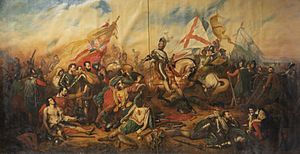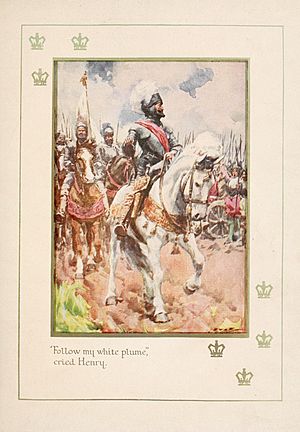Battle of Ivry facts for kids
Quick facts for kids Battle of Ivry |
|||||||
|---|---|---|---|---|---|---|---|
| Part of the French War of Religion (1587–1594) and the Anglo–Spanish War | |||||||
 Henry IV at the battle of Ivry, by Charles de Steuben (1838–1842). |
|||||||
|
|||||||
| Belligerents | |||||||
Supported by: |
Supported by: |
||||||
| Commanders and leaders | |||||||
| Strength | |||||||
| 12,000 infantry, 3,000 cavalry |
13,000 infantry, 4,000 cavalry |
||||||
| Casualties and losses | |||||||
| 500 | 6,000 killed or wounded 4,000 prisoners |
||||||
The Battle of Ivry was a very important fight that happened on March 14, 1590. It was part of the French Wars of Religion, a time when different groups in France fought over religion.
This battle was a big win for Henry IV of France. He led the French royal army and English soldiers. They fought against the Catholic League, led by the Duc de Mayenne, and Spanish forces under the Count of Egmont. After winning, Henry's army went on to try and capture Paris.
The battle took place on a flat area near Ivry, a town now called Ivry-la-Bataille. This area is in Normandy, France. Ivry-la-Bataille is located by the Eure river, about 30 miles west of Paris.
Contents
Before the Battle: Setting the Scene
King Henry IV quickly moved to surround Dreux. This town was controlled by the Catholic League. The Duke of Mayenne followed Henry, planning to stop the siege. Henry pulled back but stayed close enough to be seen. He set up his army on the Saint André plain, between the towns of Nonancourt and Ivry.
Who Fought at Ivry?
King Henry had received extra help from English troops. These soldiers were sent by Queen Elizabeth I of England.
- Henry's army had about 12,000 foot soldiers. This included English and Swiss fighters. He also had 3,000 men on horseback.
- The Catholic League's army was led by the Duke of Mayenne. They had about 13,000 foot soldiers. They also had 4,000 cavalry (soldiers on horseback). This army included citizens, rebellious nobles, and German and Swiss hired soldiers. About 2,000 Spanish pikemen and cavalry also joined them. These Spanish troops came from Flanders and were led by Philip, Count of Egmont.
The Battle Begins: A King's Speech
The two armies started fighting at dawn on March 14, 1590.
Before the fight, King Henry gave a famous speech to his soldiers. He told them:
"Companions! If you today run at risk with me, I will also run at risk with you; I will be victorious or die. God is with us. Look at his and our enemies. Look at your king. Hold your ranks, I beg of you; and if the heat of battle makes you leave them, think also of rallying back: therein lies the key to victory. You will find it among those three trees that you can see over there on your right side. If you lose your ensigns, cornets or flags, do never lose sight of my panache; you will always find it on the road to honour and victory."
He told them to look for his white plume (a feather decoration on his helmet). This was a sign of where he was fighting.
The Fight Unfolds
The battle started with powerful cannon shots from Henry's six cannons. These cannons were commanded by La Guiche. Then, the cavalry from both sides crashed into each other with great force.
The Duke of Mayenne attacked with hired soldiers from Guelders and Almaine. These soldiers were mostly on the Protestant side. They fired their guns into the air and lowered their spears, not really fighting. Mayenne's attack was so strong that after a fierce fight, his left side of the army ran away. His right side was broken through and gave up.
Henry's commanders, like Aumont, fought bravely. They pushed back the League's light cavalry. Marshal de Biron, who was in charge of the rear-guard, joined the king. Henry kept chasing the enemy after his victory, even crossing the Eure river.
The most important moment happened when the King himself charged the League's lancers. These lancers were soldiers with long spears. They couldn't get enough space to use their weapons effectively.
Mayenne's forces were pushed back. The Duke of Aumale was forced to give up. The Count of Egmont was killed. The Duke of Mayenne had lost the battle. Henry chased the defeated soldiers. Many of them surrendered because their horses were too tired to escape. The countryside was filled with fleeing League and Spanish soldiers. Henry's victorious army chased them, breaking up any groups that tried to gather again.
After the Battle: A King's Next Steps
Henry's victory at Ivry made him the strongest person claiming the throne of France. However, he was not able to capture Paris right away. He would not be accepted into the city until 1594. This happened after he changed his religion to Roman Catholicism the year before. Henry was told that the people of Paris, like many French people, would not accept a Protestant king.
A famous poem about this battle was written by Thomas Babbington Macaulay. It is called "The Battle of Ivry." It starts with these lines:
Now glory to the Lord of Hosts, from whom all glories are!
And glory to our Sovereign Liege, King Henry of Navarre!


